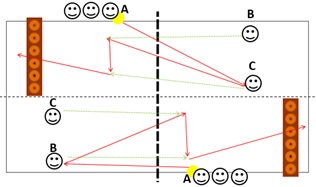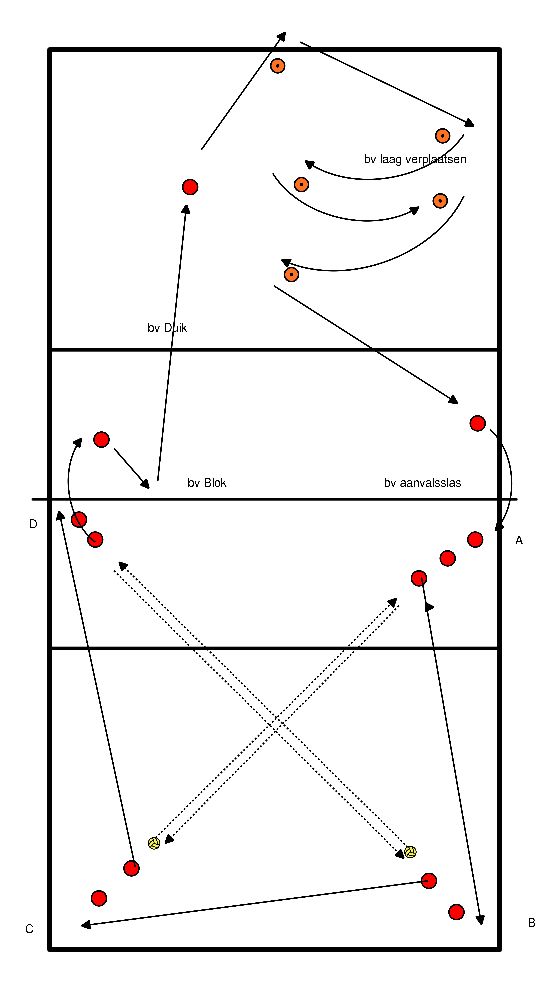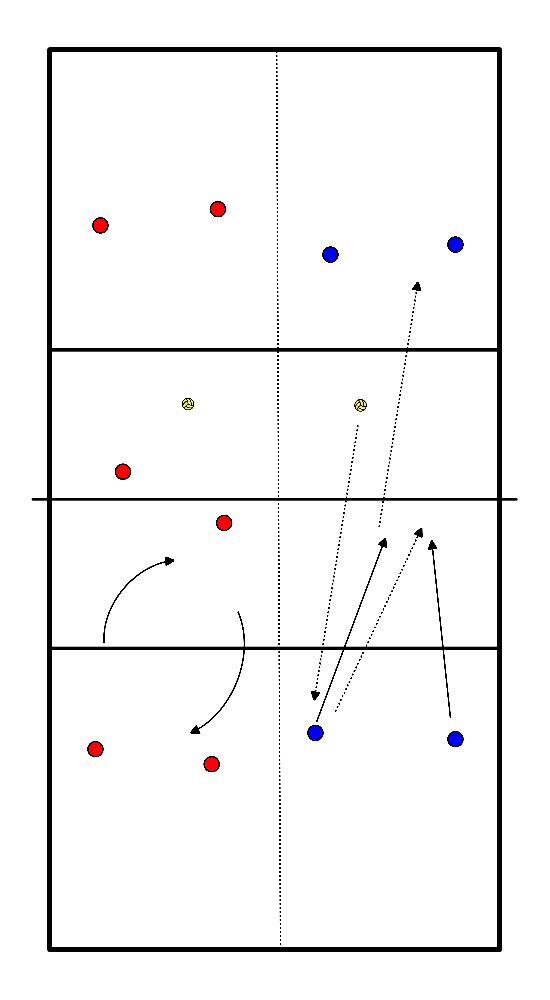Volleyball drills

- Player A throws ball over the net.
- Player B or C passes the ball over the net.
- The other player quickly runs under the net and sets up the ball for the same player who passed.
- This player tries to get a pawn off the bench with overhand play or a hitting move.
Which pair or team has knocked the most pawns off the bench after X number of minutes?
- Players stand in square on one half of the field and play balls diagonally from corner a to c and b to d.
- The players move clockwise after playing the ball.
- When they arrive at d, they do exercises on the free field, the trainer decides which exercises to do.
- After the exercises, they join again at corner a.

- 3 against 3 or 2 tegn 2 (depending on number of players) on half court.
- The ball must be kept in play on control.
- Two players in the back of the court, the one who does not pass comes in for set up.
- In case of 3 against 3, 1 player stands at the net and turns if the ball doesn't go over the net.
- When they have passed the ball over the net 10 times in a row, they may go to the next level.
- When the ball falls on the ground they start counting again.
- Points of attention: on control, technical ball control
- 1) attack out of position
- 2) with jump - hit calmly and aimed - (withheld)
- 3) with jump full force - hit aimed
- 4) hit free from the trap.

- Balls often don't land neatly on the aerial as the attackers would like, they stay hanging/ out of the net/ or outside the aerial.
- Execution:
- The players receive a ball and learn to correct it.
- 1st pass is always used the same.
- 2nd and3rd passes will be used to correct.
- Balls will be thrown in underhand in the following positions.
- Position 1 Out of the net: -> player must stay behind the ball.
- Position 2 Hangs on: -> player must accelerate to the inside
- Position 3: outside the aerial: -> player must step outside
- Get behind the ball
- - So that you can hit the ball diagonally in front of you.
- Players can throw the ball in themselves or at one side through the trainer.
- step 1) catch the ball from the run-up
- Point of attention: get behind the ball well, do not hover, keep making the attacking pass.
- step 2) attack

- One person at the net.
- Four on the back line they play the ball back to the one person at the net each time.
- The defenders play the ball in private.
- Person at the net varies with the ball long short the viewer must move.
- two people one goes on the hands in plank position.
- The other one lifts the legs up.
- The person who lifts up the legs lets go of one leg at a time.
- If fat does happen then a point for the person who holds the legs.
- Everyone on one side and then overhead service.
- do it once.
- Then one by one give attention.
- Foot forward, other foot diagonal and keep it on the ground.
- Make two teams and two goals from cones.
- The ball has to stay low to the ground so sit low and then play the ball with your flat hand.
- Who first scores a goal.
- Stop after about 15 minutes.
- Then record the score who has scored the most has won.
You go in the running pass to the net and back to the back line.
- To the net you swing your left arm forward and back to the baseline your left arm back.
- Now you do the same as step 1 but with your right arm.
- Now you go heel-toe, this means that your heels have to touch your buttocks, you do this with a straight back (chest out) and your hands behind against your buttocks. You do this with a straight back (chest out) and your hands against the back of your buttocks.
- Now you are going to lift your knee, this is when you lift your knees to 90 degrees, the height of your hips. You do this with a straight back (chest out), towards the net and back to the baseline.
- You are now going to do the sideways pass, this means that you look with your body to one side and move sideways. You do this in the same way as the shuffle. If you go from the net back to the baseline you turn around again.
- Finally you do the cross pass, this means that you look with your body to one side and cross your legs, your arms move with you from left to right.
- You stand about 3 meters from a wall, you do the attack run. (attack pass) Short-long- close pass (brake pass).
- If you get too close to the wall with the brake pass, you have to look at how big your 2 previous passes were.
- With the brake pass/ close pass you make sure your striking hand touches the wall (don't put too much force on it)
- You take your arms with you, so with the short arms to the front, with long arms to the back, with the brake pass bring your arms up.
- Pay attention:
- Make sure you don't end up too close to the wall.
- Or that you hit the wall with your face.
- Also keep an eye on your technique and how your feet end up.
You go in the running pass to the net and back to the back line.
- To the net you swing your left arm forward and back to the baseline your left arm back.
- Now you do the same as step 1 but with your right arm.
- Now you go heel-toe, this means that your heels have to touch your buttocks, you do this with a straight back (chest out) and your hands behind against your buttocks. You do this with a straight back (chest out) and your hands against the back of your buttocks.
- Now you are going to lift your knee, this is when you lift your knees to 90 degrees, the height of your hips. You do this with a straight back (chest out), towards the net and back to the baseline.
- You are now going to do the sideways pass, this means that you look with your body to one side and move sideways. You do this in the same way as the shuffle. When you go from the net back to the baseline you turn around again.
- Finally you do the cross pass, this means that you look with your body to one side and cross your legs, your arms move with you from left to right.
- with 3 teams, or else 2 teams:
- throw the ball over, 1 to 2, 2 to 3, 3 to 2, 2 to 1. After 5 turns, 1 position.
- Throw pass. 1 throw to 2, 2 pass to 3, 3 throw to 2, 2 pass to 1. After 5 turn overs 1 position
- smash, pass variant
- smash, pass, smash, pass
- throw, pass, BH, pass, etc.








